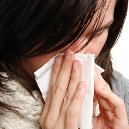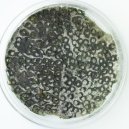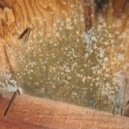Find a pre-screened local mold removal specialist Free Estimate
Find a Mold Specialist Now
Click or Call, Toll-Free 24/7
Alternaria Mold in the Home
Like its cousins, cladosporium and penicillium, alternaria is one of the most common types of outdoor mold. There are more than 40 known species of this fungi, which is often responsible for leaf spots and degenerative diseases on trees and bushes. As a major plant pathogen, it is most commonly found in the environment in spring and summer.
No matter the season or location, alternaria mold lingers in the air on dry, windy days. When picked up by a breeze, it can become airborne and enter your home, looking for a warm and humid place to start a mold colony. Unfortunately, if alternaria mold gets into your house, it may settle on your produce, houseplants, furniture, or clothing. It can also live and grow under your carpets and inside walls. Mold companies often find spores growing in the shower, basement, and attic. Homes containing higher than normal humidity are especially susceptible to this type of fungi growth, which may reach tens of thousands of spores per cubic foot.
Mold Health Risks
If mold enters and grows inside your home, it can cause a variety of health problems for you and your family. The mildest of symptoms are similar to the common cold, which includes a runny nose, cough, and sore throat. Some people also get itchy and irritated eyes or experience wheezing, difficulty breathing, and shortness of breath. Hives and skin rashes are also possible.
People with asthma are particularly susceptible to mold illness. According to the Centers for Disease Control and Prevention (CDC), exposure to alternaria is a well-known asthma risk factor. Also, families with infants should be especially cautious about mold exposure. Babies who breathe in toxic spores can experience all of the respiratory-related symptoms above due to the fact that their immune systems are not fully developed. They are also at an increased risk of SIDS and crib death.
Older people and patients with emphysema or COPD can have severe reactions and health complications. If you or a loved one has any signs of mold exposure, make an appointment with your primary care physician. Upon examination, your doctor should be able to determine if you have a cold, contagious respiratory illness, or are suffering from an environmental issue such as mold exposure. Depending on the results, they may want to refer you to an allergist or an ear, nose, and throat specialist.
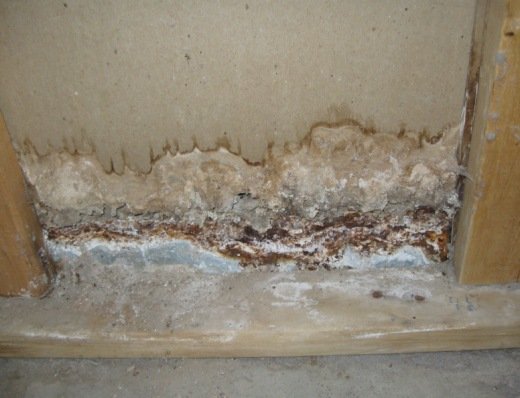 Alternaria mold on back of sheetrock
Alternaria mold on back of sheetrockHow to Prevent Alternaria Mold in the Home
There are many ways to prevent the development of alternaria mold in your home. While you should practice prevention all year long, it is especially important to take action during summer. Keep all entryways closed as much as you can, especially when it is hot, windy, and dry. It is also important to fix any air leaks around doors or windows and address any areas of your roof that may have been damaged due to summer storms. Make sure that all of your home’s gutters are firmly attached, that they are free of clogging debris, and that the downspouts are directed away from the home’s foundation.
Dark, damp areas are ideal places for spores to lodge and begin to grow. Check for leaks in your bathroom and kitchen regularly. Look under sinks, around toilets, dishwashers, and washing machines, which may become a source of slow leaks. These hidden areas can become breeding grounds for mold. We also recommend installing leak detectors. These small devices are available online or at home improvement stores, and will sound when they detect moisture. You should place them next to your water heater, under your sinks, and anywhere else in your home where there is a water source that may develop a leak.
You can reduce the humidity level inside the house by keeping your HVAC system running on the auto setting. You can also use a dehumidifier in areas that typically have higher humidity levels, such as the basement. Keep humidity levels as low as you can; humidity readings should go no higher than 45 to 50 percent. The EPA also recommends getting your home’s air ducts cleaned periodically. You should also insulate your house if it needs it. Your air conditioner and humidity levels will be easier to control, and you will save money on your utility bills. If you have not visited your attic recently, take a look. Poor ventilation combined with excess moisture can lead to mold growth. If your attic has a musty odor, you may have something growing inside, even if you cannot see it.
Finally, clean your bathrooms and basement regularly with mold killing products. Never carpet your bathroom. If you have a sauna in your home, be especially careful to maintain the heating system properly and remove excess moisture from the walls, seats, and floor.
How to Rid Your Home of Mold
Mold is difficult to remove on your own, particularly if you or a member of your household has health problems. If you think you have mold growing in your home, call a mold remediation company right away. The U.S. Environmental Protection Agency (EPA) recommends hiring a professional if mold covers an area larger than 3 feet by 3 feet, if you have mold in your HVAC system, if the mold was caused by contaminated water or sewage, or if you have any health concerns.
Some homeowners try to remove large mold growths with bleach. Most bleach products are made up of 96 percent water and only 4 percent chlorine. It is not effective on non-porous materials like drywall, wood, or carpet. Be sure to use the proper personal protective equipment like safety goggles, a mask or respirator, rubber gloves, and boots. Here is more on personal safety equipment.
If you rent your home, call your property owner or landlord at the first sign of mold. If possible, take pictures of the damage. If you have problems reaching someone to help, contact your community’s health board or local department of health.
While mold grows best in warmer seasons, it is possible for it to grow in your home year-round. If you believe you have mold inside your home, do not wait until it spreads, or your family becomes ill. You can schedule a free in-home consultation with an experienced mold removal company in your area to look for signs, and if necessary, perform an efficient and convenient removal. Whether you have indicators of mold or not, a professional evaluation can provide you with expert advice at no cost to you. To get started, follow this link to get a list of qualified mold removal professionals in your area. Depending upon the situation, your homeowners insurance policy may cover the removal costs.
Free Home Inspection By A Mold Removal Specialist
Search This Website
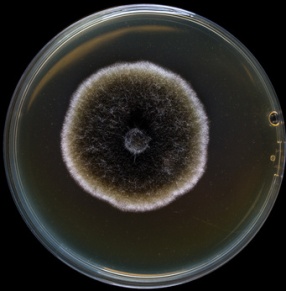 Alternaria mold
Alternaria moldRecent Articles
-
See Our 5 Recommended Mold Removal Companies in Covington, KY
Apr 16, 25 12:59 PM
-
See Our 5 Recommended Mold Removal Companies in Wheaton, IL
Jun 20, 24 10:33 AM
-
See Our 5 Recommended Mold Removal Companies in Aberdeen, SD
Oct 08, 21 04:05 PM
